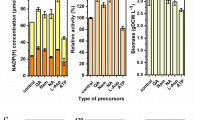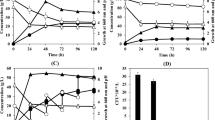Abstract
It is well known that cofactors play a key role in the production of different compounds in bioconversion processes, while the high cost of cofactors limits their usage in industrial applications. In the present study, a NADH regeneration system was successfully developed in Lactobacillus plantarum by expressing the fdh gene coding for formate dehydrogenase (FDH) from Candida boidinii. Results indicated that the FDH was expressed with the highest activity of 0.82 U/mg of protein when cells entered early stationary phase. In addition, the expression of FDH increased the intracellular level of NADH and NADH/NAD+ ratio in L. plantarum, and therefore, enhanced the NADH-dependent production of 3-phenyllactic acid (PLA) in repeated and fed-batch bioconversions. In brief, the results demonstrate that the NADH regeneration by expressing FDH is a promising strategy for producing NADH-dependent microbial metabolites in L. plantarum.





Similar content being viewed by others
References
Mu WM, Yu SH, Zhu LJ, Zhang T, Jiang B (2012) Recent research on 3-phenyllactic acid, a broad-spectrum antimicrobial compound. Appl Microbiol Biotechnol 95(5):1155–1163
Zheng ZJ, Ma CQ, Gao C, Li FS, Qin JY, Zhang HW, Wang K, Xu P (2011) Efficient conversion of phenylpyruvic acid to phenyllactic acid by using whole cells of Bacillus coagulans SDM. PLoS ONE 6:e19030
Vermeulen N, Ganzle MG, Vogel RF (2006) Influence of peptide supply and cosubstrates on phenylalanine metabolism of Lactobacillus sanfranciscensis DSM20451(T) and Lactobacillus plantarum TMW1.468. J Agric Food Chem 54:3832–3839
Li XF, Jiang B, Pan BL (2007) Biotransformation of phenylpyruvic acid to phenyllactic acid by growing and resting cells of a Lactobacillus sp. Biotechnol Lett 29:593–597
Valerio F, Di Biase M, Lattanzio VMT, Lavermicocca P (2016) Improvement of the antifungal activity of lactic acid bacteria by addition to the growth medium of phenylpyruvic acid, a precursor of phenyllactic acid. Int J Food Microbiol 222:2221–2227
Li L, Shin SY, Lee KW, Han NS (2014) Production of natural antimicrobial compound d-phenyllactic acid using Leuconostoc mesenteroides ATCC 8293 whole cells involving highly active d-lactate dehydrogenase. Lett Appl Microbiol 59:404–411
Mu WM, Chen C, Li XF, Zhang T, Jiang B (2009) Optimization of culture medium for the production of phenyllactic acid by Lactobacillus sp. SK007. Bioresour Technol 100(3):1366–1370
Mu WM, Liu FL, Jia JH, Chen C, Zhang T, Jiang B (2009) 3-Phenyllactic acid production by substrate feeding and pH-control in fed-batch fermentation of Lactobacillus sp. SK007. Bioresour Technol 100(21):5226–5229
Rodríguez N, Salgado JM, Cortés S, Domínguez JM (2012) Antimicrobial activity of d-3-phenyllactic acid produced by fed-batch process against Salmonella enterica. Food Control 25(1):274–284
Stephanopoulos G (1999) Metabolic fluxes and metabolic engineering. Metab Eng 1(1):1–11
San KY, Bennett GN, Berríos-Rivera SJ, Vadali RV, Yang YT, Horton E, Rudolph FB, Sariyar B, Blackwood K (2002) Metabolic engineering through cofactor manipulation and its effects on metabolic flux redistribution in Escherichia coli. Metab Eng 4:182–192
Foster JW, Park YK, Penfound T, Fenger T, Spector MP (1990) Regulation of NAD metabolism in Salmonella typhimurium: molecular sequence analysis of the bifunctional nadR regulator and the nadA-pnuC operon. J Bacteriol 172:4187–4196
Ma Z, Shentu XP, Bian YL, Yu XP (2013) Effects of NADH availability on the Klebsiella pneumonia strain with 1,3-propanediol operon over-expression. J Basic Microbiol 53:348–354
Li XF, Jiang B, Pan BL, Mu WM, Zhang T (2008) Purification and partial characterization of Lactobacillus species SK007 lactate dehydrogenase (LDH) catalyzing phenylpyruvic acid (PPA) conversion into phenyllactic acid (PLA). J Agric Food Chem 56(7):2392–2399
Kaup B, Bringer-Meyer S, Sahm H (2004) Metabolic engineering of Escherichia coli: construction of an efficient biocatalyst for d-mannitol formation in a whole-cell biotransformation. Appl Microbiol Biotechnol 64:333–339
Zhang Y, Huang Z, Du C, Li Y, Cao Z (2009) Introduction of an NADH regeneration system into Klebsiella oxytoca leads to an enhanced oxidative and reductive metabolism of glycerol. Metab Eng 11:101–106
Xu GC, Zhang LL, Ni Y (2016) Enzymatic preparation of d-phenyllactic acid at high space-time yield with a novel phenylpyruvate reductase identified from Lactobacillus sp. J Biotechnol 222:29–37
Lin SS, Miyawaki O, Nakamura K (1999) Continuous production of l-carnitine with NADH regeneration by a nanofiltration membrane reactor with coimmobilized l-carnitine dehydrogenase and glucose dehydrogenase. J Biosci Bioeng 87(3):361–364
Wang Y, Li LX, Ma CQ, Gao C, Tao F, Xu P (2013) Engineering of cofactor regeneration enhances (2S,3S)-2,3-butanediol production from diacetyl. Sci Rep 3:2643
Berrios-Rivera SJ, Bennett GN, San KY (2002) Metabolic engineering of Escherichia coli: increase of NADH availability by expressing an NAD+-dependent formate dehydrogenase. Metab Eng 4:217–229
Kratzer R, Pukl M, Egger S, Nidetzky B (2008) Whole-cell bioreduction of aromatic α-keto esters using Candida tenuis xylose reductase and Candida boidinii formate dehydrogenase co-expressed in Escherichia coli. Microb Cell Fact 7:37
Liu WM, Ma HM, Luo JX, Shen WH, Xu X, Li S, Hu Y, Huang H (2004) Efficient synthesis of l-tert-leucine through reductive amination using leucine dehydrogenase and formate dehydrogenase coexpressed in recombinant E. coli. Biochem Eng J 91:204–209
Van de Guchte M, Van der Vossen JM, Kok J, Venema G (1989) Construction of a Lactococcal expression vector: expression of hen egg white lysozyme in Lactococcus lactis subsp. lactis. Appl Environ Microbiol 55(1):224–228
Kolandaswamy A, George L, Sadasivam S (2009) Heterologous expression of oxalate decarboxylase in Lactobacillus plantarum NC8. Curr Microbiol 58:117–121
Bradford MM (1976) A rapid and sensitive method for quantitation of microgram quantities of protein utilizing the principle of protein–dye binding. Anal Biochem 72:248–254
Cheng X, Liu F, Zhang YX, Jiang YS (2013) Cloning and expression of a urate oxidase and creatinine hydrolase fusion gene in Escherichia coli. Ren Fail 35(2):275–278
Mnisi SM (2006) Cloning, properties and expression of a novel esterase from Bacillus coagulans strain 18-11. Dissertation, University of Pretoria
Brurberg MB, Haandrikman AJ, Leenhouts KJ, Venema G, Nes IF (1994) Expression of a chitinase gene from Serratia marcescens in Lactococcus lactis and Lactobacillus plantarum. Appl Microbiol Biotechnol 42(1):108–115
Miao YZ, Xu H, Fei BJ, Qiao DR, Cao Y (2013) Expression of food-grade phytase in Lactococcus lactis from optimized conditions in milk broth. J Biosci Bioeng 116(1):34–38
Ji XJ, Xia ZF, Fu NH, Nie ZK, Shen MQ, Tian QQ, Huang H (2013) Cofactor engineering through heterologous expression of an NADH oxidase and its impact on metabolic flux redistribution in Klebsiella pneumonia. Biotechnol Biofuels 6:7
Li N, Wang YL, Zhu P, Liu ZM, Guo BH, Ren J (2015) Improvement of exopolysaccharide production in Lactobacillus casei LC2W by expression of NADH oxidase gene. Microbiol Res 171:73–77
Zheng ZJ, Zhao MY, Zang Y, Zhou Y, Ouyang J (2015) Production of optically pure-phenyllactic acid by using engineered Escherichia coli coexpressing l-lactate dehydrogenase and formate dehydrogenase. J Biotechnol 207:47–51
Yu SH, Zhu LJ, Zhou C, An T, Jiang B, Mu WM (2014) Enzymatic production of d-3-phenyllactic acid by Pediococcus pentosaceus d-lactate dehydrogenase with NADH regeneration by Ogataea parapolymorpha formate dehydrogenase. Biotechnol Lett 36:627–631
Jia JH, Mu WM, Zhang T, Jiang B (2010) Bioconversion of phenylpyruvate to phenyllactate, gene cloning, expression, and enzymatic characterization of d- and l1-lactate dehydrogenase from Lactobacillus plantarum SK002. Appl Biochem Biotechnol 162(1):242–251
Reed MC, Lieb A, Nijhout HF (2010) The biological significance of substrate inhibition: a mechanism with diverse functions. BioEssays 32:422–429
Lin SKC, Du CY, Koutinas A, Wang RH, Webb C (2008) Substrate and product inhibition kinetics in succinic acid production by Actinobacillus succinogenes. Biochem Eng J 41(2):128–135
Acknowledgements
This research was supported by Natural Science Foundation of the Higher Education Institutions of Jiangsu Province (Grant no. 16KJB180033).
Author information
Authors and Affiliations
Corresponding author
Additional information
Publisher's Note
Springer Nature remains neutral with regard to jurisdictional claims in published maps and institutional affiliations.
Rights and permissions
About this article
Cite this article
Li, M., Meng, X., Sun, Z. et al. Effects of NADH Availability on 3-Phenyllactic Acid Production by Lactobacillus plantarum Expressing Formate Dehydrogenase. Curr Microbiol 76, 706–712 (2019). https://doi.org/10.1007/s00284-019-01681-0
Received:
Accepted:
Published:
Issue Date:
DOI: https://doi.org/10.1007/s00284-019-01681-0




